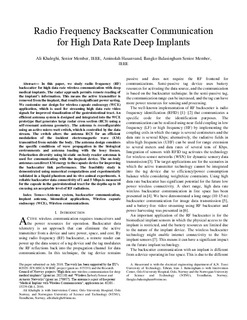Radio frequency backscatter communication for high data rate deep implants
Journal article, Peer reviewed
Accepted version

Åpne
Permanent lenke
http://hdl.handle.net/11250/2638519Utgivelsesdato
2019Metadata
Vis full innførselSamlinger
Originalversjon
IEEE transactions on microwave theory and techniques. 2019, 67 (3), 1093-1106. 10.1109/TMTT.2018.2886844Sammendrag
In this paper, we study the radio frequency (RF) backscatter for high data rate wireless communication with deep medical implants. The radar approach permits remote reading of the implant's information. This means that the active transmitter is removed from the implant that results in significant power saving. We customize our design for wireless capsule endoscopy (WCE) application, which is used for streaming high data rate video signals for improved visualization of the gastrointestinal tract. An efficient antenna system is designed and integrated into the WCE prototype that generates large radar cross section (RCS) using a self-resonant antenna geometry. The antenna is reconfigurable using an active microwatt switch, which is controlled by the data stream. The switch alters the antenna RCS for an efficient modulation of the incident electromagnetic (EM) wave transmitted from outside the body. The antenna design considers the specific conditions of wave propagation in the biological environments and antenna loading with the lossy tissues. Polarization diversity using bistatic on-body reader antennas is used for communicating with the implant device. The on-body antennas can direct EM energy to the capsule device for improving the backscatter link performance. The feasibility study is demonstrated using numerical computations and experimentally validated in a liquid phantom and in-vivo animal experiments. A reliable backscatter data connectivity of 1 and 5 Mb/s is measured for the capsule in the gastrointestinal tract for the depths up to 10 cm using an acceptable level of RF radiations.